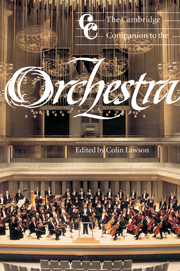Book contents
- Frontmatter
- 1 The history of the orchestra
- 2 The development of musical instruments: national trends and musical implications
- 3 The orchestral repertory
- 4 From notation to sound
- 5 The art of orchestration
- 6 The history of direction and conducting
- 7 International case studies
- 8 The revival of historical instruments
- 9 Recording the orchestra
- 10 Training the orchestral musician
- 11 The life of an orchestral musician
- 12 Historical recordings of orchestras
- 13 The orchestral composer
- 14 Educational programmes
- 15 The future of the orchestra
- Notes
- Appendices
2 - The development of musical instruments: national trends and musical implications
Published online by Cambridge University Press: 28 September 2011
- Frontmatter
- 1 The history of the orchestra
- 2 The development of musical instruments: national trends and musical implications
- 3 The orchestral repertory
- 4 From notation to sound
- 5 The art of orchestration
- 6 The history of direction and conducting
- 7 International case studies
- 8 The revival of historical instruments
- 9 Recording the orchestra
- 10 Training the orchestral musician
- 11 The life of an orchestral musician
- 12 Historical recordings of orchestras
- 13 The orchestral composer
- 14 Educational programmes
- 15 The future of the orchestra
- Notes
- Appendices
Summary
Development in context
Discussion of the development of musical instruments inevitably raises questions of cause and effect: did composers demand changes to instruments, were these encouraged by performers, or were the instrument makers responsible? A popularly held belief since the rise of organology as a discipline in the nineteenth century is that of a progressive and essentially evolutionary process. European citizens were surrounded by mechanical development, social engineering, and the maturation of scientific thought, while the theory of human evolution itself became formalised. Furthermore, in the processes of colonisation, European civilisation had encountered and subsumed ‘primitive’ cultures, while at the same time the artefacts and practices of these cultures started to be systematically catalogued and preserved. It was not difficult to draw general conclusions on the evolution of musical instruments by making direct comparisons between items collected from undeveloped cultures and those made and used within the Western sphere. Evolution of form and function seemed obvious. It is scarcely surprising that nineteenth-century organologists, embedded in their culture of progress and development, would theorise such a harmonious explanation.
An evolutionary theory of musical instrument development required a driving force. Given the lowly status of the artisan in the nineteenth-century social structure, it was unthinkable that developments which might influence higher intellectual pursuits could be driven from below. It was therefore necessary that the composer be charged with initiating invention.
- Type
- Chapter
- Information
- The Cambridge Companion to the Orchestra , pp. 22 - 41Publisher: Cambridge University PressPrint publication year: 2003
- 1
- Cited by



